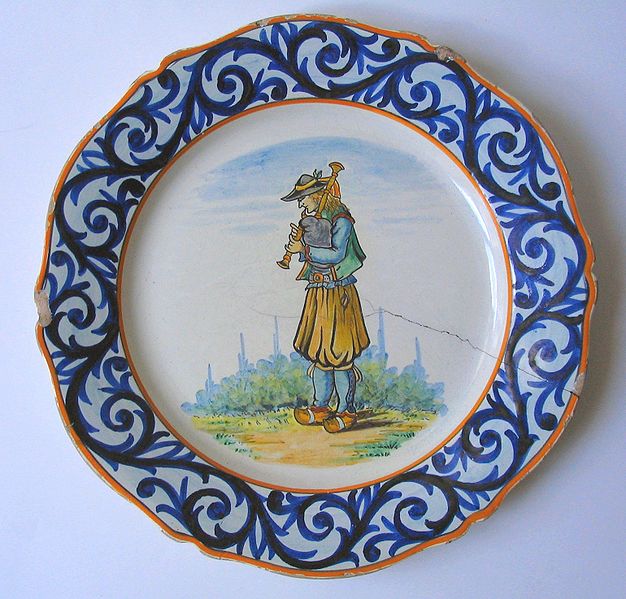Most French farmhouses have a piece or even a collection of faience. Faience is the name for a tin-glazed pottery on a pale buff earthenware body.
Faience originated in the Middle East, and may date back as far as 4000 BC. The process was brought to Spain by the Moors, was exported to Italy, and later, northern Europe. Faience gained popularity in Europe as an affordable alternative to the much more costly Chinese porcelain.
France started manfacturing faience in the early eighteen century. This movement was led by Quimper in Brittany in 1690. The village of Quimper today has a museum devoted to faience.
Most Quimper pottery has scenes of Breton men and women in traditional dress. The colors used are predominantly blue, white, and yellow.
Photo Wikipedia
"Petit Breton" Plate, Henriot, circa 1925
A newer Quimper Pitcher
Other notable factories later opened in Rouens, Strasbourg, and Luneville. The Rouens factory actually opened prior to the one at Quimper. The Rouen factory produced the first soft-paste porcelain in France as early as 1673. The process was invented by the potter Louis Poterat, who used blue designs to mimic that of Chinese hard-paste porcelain. His invention was in response to the popularity of the influx of Chinese wares generated by the 1664 creation of the French East India Company.

Rouen Soft-paste Mustard Cup, late 1600's
Rouen porcelain can be distinguished by its intense blue glaze, as well as the lightness of the porcelain. This paste was lighter than any other French type except for Sevres. However, it failed to become commercially viable, and the factory subsequently closed in 1696.
But Rouen ceramics were widely copied, and the Rouen potters moved to Sinceny and opened their own business. They produced the pitcher below.

Rouen Ewer, circa 1720 Wikipedia
Strasbourg faience (located near the German border) was the first factory to develop the "petit feu" method, which uses crimson, gold, and pink decorations. The factory was run by the Hannong family until its closure at end of the eighteenth century.
Below is an example of the work produced by this factory.

Strasbourg Faience, circa 1760 Joseph Hannong
The faience factory in Luneville was established by Jacques Chambrette in 1730. Early pieces were unmarked, but the factory is well known for its faience dogs and lions as well as for its fine biscuit figurines. It was later bought by Keller and Guerin. It is still in existence.
Luneville Faience Photo Wikipedia
More recent faience pieces sometimes can be found. They can be as beautiful as some of the older pieces.
Here is a nineteenth century French faience piece that I was lucky enough to find. It has the most vibrant blues and yellows imaginable.
19th Century, France
The French Farmhouse photo
The French Farmhouse photo
Happy hunting!




No comments:
Post a Comment